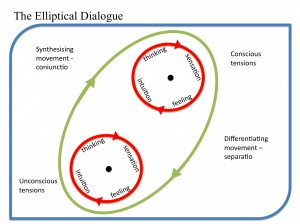Den Elliptiska Dialogen är en form för analytisk klinisk interaktion som i det sammanhanget innehåller både intrapsykiska och interpersonella upplevelser. Om du slår upp ordet ellips eller ordet elliptisk i en ordbok ser du att det är förankrat i olika perspektiv, bland annat matematik, geometri och skrift. I samtliga tre fall härstammar ordet från det grekiska élleipsis.
Jag fokuserar på ellipsen som en geometrisk form som är excentrisk och har två centra – vart och ett i ena änden av en balanserad, rundad oval form. I den elliptiska dialogen har varje centrum, varje deltagande individ, sin egen interna (intrapsykiska) dialog och är samtidigt i dialog med andra centra. Detta innebär att i analytiska sammanhang äger tre parallella dialoger rum samtidigt: två ”interna” (röda i bilden) och en yttre eller interpersonell (grön). Alla tre måste finnas inom helheten av den analytiska processen (den blå ramen).
(The Elliptical Dialogue is a form for analytical clinical interaction and in that context contains both intrapsychic and interpersonal experiences. If you look up the word ellipse or the word ellipsis in a dictionary you will find that it is grounded in different perspectives, including mathematics, geometry and writing. In all three cases the word originates from the Greek élleipsis.
I focus on the ellipse as a geometrical form that is eccentric and has two centres – each at one end of a balanced, rounded oval-shaped form. In the Elliptical Dialogue, each centre, each participating individual, has its own internal (intrapsychic) dialogue and is at the same time in dialogue with the other centre. This means that, in the analytical context, three parallel dialogues are taking place at the same time: two ’internal’ ones, coloured red, and an outer or interpersonal one, coloured green. All three must be contained within the wholeness of the analytical process, the blue frame.)

